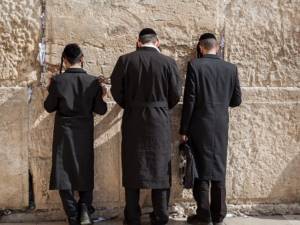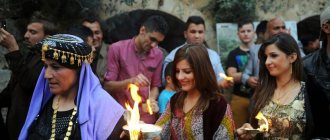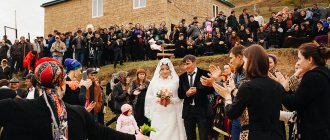Engagement ceremony
Like many peoples, Jews have honored their traditions since ancient times. Parents selected the bride and groom with the help of a yentami (matchmaker). All preparations for the Jewish wedding ceremony of Chuppah fell on the shoulders of the fathers and mothers of the newlyweds. A modern Jewish wedding involves the meeting of the bride and groom before the ceremony, but without entering into premarital relations.
After both parties have agreed on the wedding, the future husband comes to the bride's father and asks for permission to marry. This is a formality, but this is the traditional custom. As a sign of confirmation of his intentions, the young man pays a ransom for his beloved.
Wedding scale
After all the rituals, the real fun begins. At a Jewish wedding they love to sing, have fun and dance. Jews don't have small weddings. It is believed that 200 people is a small wedding, 400 guests is a medium wedding, and a large wedding is 600-700 people. Banquet halls earn a lot of money during this festival. The average bill per guest in Tel Aviv for young people is 200–300 shekels. If you take into account the host, musicians and decor, the average bill rises to 500 shekels per guest. At a Jewish wedding, it is customary to give only money or checks, which will help pay for the wedding a little.
KNOWLEDGE BASE: Congratulations at the wedding of bridesmaids as an interesting and unique gift for a long memory
Ceremony
After the betrothal, the initial stage of the festive ceremony—tenaim—begins. This ritual involves breaking a plate as a sign of mourning for the destroyed temples of Jerusalem.
The day of the ceremony is set following strict rules. The ceremony is not performed during holidays, for example, on Shabbat, but begins to be celebrated at the end on Saturday evening.
Interesting! Compare with the Orthodox.
Depending on the nationality of the Jews, there are their own traditions for the day of Chuppah. The Mishnah plans a celebration for Wednesday so that the deceived spouse can present evidence for the public to see the next day. In some countries, a Jewish wedding is combined with a Shabbat feast. But Sunday still remains popular.
Shortly before the wedding ceremony, the betrothed buys a ring for the Jewish bride. The ring should be without frills and have a smooth surface.
The holiday is celebrated on any date of the year with the exception of the period between Passover and Shavuot, which is a time of mourning for all Israelis.
Ufruf for a Jewish youth
A week before the celebration, a holiday is organized for the groom during the service in the Ufruf Synagogue. The future spouse announces to the community his intention to marry. During the announcement of the upcoming event, the guy is showered with candy, and then a festive dinner follows.
Mikvah for a Jewish newlywed
On these days, the bride also prepares and undergoes a purification ceremony in the Mikvah pool. This custom still exists today in a modern style.
The ritual is to cleanse not only the body, but also the soul. The bride takes off all her clothes, jewelry, even makeup is removed from her face. Gradually the girl enters the water, reciting a prayer.
The Jewish bride does not go through the ritual alone in the pool; women from the family enter the Mikvah with her. During the ceremony, women share the secrets of family happiness and give parting words. A respectable and religious elderly woman also gives parting speeches.
The week before the holiday
In ancient times, newlyweds were not supposed to see each other and fast seven days before the wedding. In the modern world, these traditions are not so zealously observed; the groom fasts, and then only on the wedding day. This custom speaks of entering into marriage pure and renewed. The religion also influences modern Jews, but they are observed in a less strict form.

Story
The word chuppah
originally appears in the Tanakh (such as Joel 2:16; Psalms 19:5).
Abraham P. Bloch argues that the connection between the term chuppah
and the marriage ceremony "can be traced back to the Bible," but "the physical appearance of the chuppah and its religious meaning have undergone many changes since then."[5]
In biblical times, a couple consummated their marriage in a tent[6], which in the Talmudic period was called a chuppah[7]. The Babylonian Talmud, however, makes reference to a wedding canopy (Gittin 57a): “It was the custom when a boy was born to plant a cedar tree, and when a girl was born to plant a pine tree, and when they were married, the tree was cut down and the branches were made into a canopy.”
Jewish marriages consist of two parts: the betrothal ceremony, known as erusin
or
kiddushin
, and the actual marriage ceremony known as
nisuin
.
Initially, the two ceremonies were usually performed separately[1]. After the initial engagement, the bride lived with her parents until the day of the actual marriage ceremony; The wedding ceremony then took place in a room or tent that the groom had equipped for the bride. After the ceremony, the bride and groom spent an hour together in a regular room, and then the bride entered the chuppah
, and after receiving her permission, the groom joined her.[7]
In the Middle Ages, these two stages were increasingly combined into one ceremony, and the chuppah lost its original meaning, being replaced by various other customs[8]. Indeed, in post-Talmudic times the use of the rest of the chuppah
came to naught[7];
the tradition that became most widespread in its place was “to perform the entire united ceremony under a canopy, to which the term Chuppah
, and to regard the entry of the bride under the canopy as a symbol of the consummation of the marriage.”[8] The canopy “caused an association with the room”[7].
Nisuin wedding ceremony
Chuppah is not always held in the Synagogue; a rabbi and the chuppah itself are needed to perform the custom. The rabbi can also observe from the side how one of the respected relatives performs the ceremony.
The chuppah is the canopy on which the newlyweds stand during the ceremonial part of the celebration. The structure is built to look like a house, four columns with fabric on top. The man is the first to enter under the canopy, personifying the owner of the house. Then the girl enters, accompanied by her parents or father. This ritual symbolizes that the husband is now responsible for the wife.
The betrothed should make from one to seven circles around her husband, depending on which one is preferred. There is also a ritual when the groom covers his face with his beloved’s veil, symbolizing protection.
And only then does the betrothal ceremony take place. Before the actual presentation of the ring, blessings are read over the wine and the ceremony begins. Afterwards the blessed wine is drunk by the young people. According to ancient customs, the husband gives his wife a ring and makes a solemn speech. According to different traditions, the spouse’s ring is worn both under the chuppah and when leaving it.
The blessings are read either by a rabbi or by respectable men. If guests have the honor of reading a blessing, then each invitee reads one. Wine is also drunk first by the husband and then by the wife.
The custom of “breaking the glass” concludes the ceremony. The newlywed tramples the glass with his right foot. All guests congratulate the newlyweds and shout “Mazel tov!”, this is a wish for happiness to the newlyweds.

Main ritual under the chuppah
The place where the groom meets his future wife, a kind of tent, is called the chuppah. A man, as it were, invites his woman into his home. According to tradition, the chuppah must be placed outside, but in unfavorable weather conditions it is allowed to be installed inside the synagogue.
To the sounds of Jewish music, mothers lead the bride under the chuppah, where the rabbi, groom and fathers are already waiting for her. The rabbi reads a prayer over a glass of wine, after which the young people take a sip from it.
What follows is the same marriage proposal. The groom takes out the ring and shows it to all witnesses. It must be wide enough without any decoration; stones and engraving are strictly prohibited.
Editor's Choice: Wedding Day Celebrations: How to Strengthen and Refresh the Senses
The groom says the sacred words: “Behold, you are dedicated to me as a wife with this ring according to the law of Moses and Israel” - and puts the ring on his wife’s index finger. Subsequently, the bride will change it to a nameless one.
The rabbi reads out the text of the Ketuba, and then the groom solemnly hands over this scroll to the bride, who must now look after it and treasure it like the apple of her eye. And at the end of the sacrament, seven wedding blessings are read over the second glass of wine.
At the end, the groom breaks the glass, and the newlyweds go to a special room, where they are alone for some time, communicate and relax. At this time, no one has the right to enter there.
Subtleties
Jews do not have traditional wedding dresses. The newlywed wears a black suit, and the bride wears a white modest dress. The male part of the wedding, together with the rabbi, covers their heads with white yarmulkes.
Before the wedding ceremony, it is customary to sign a marriage contract, which discusses the responsibilities of both parties and the amount the woman can expect after a divorce. The Ketubah must contain a clause in which the spouse gives his consent to the ex-wife’s entry into a subsequent marriage.
There is also no special musical composition; they include either a quiet Jewish melody or Wagner’s Wedding March. But the tradition of throwing a wedding bouquet originates from the Jewish people.
Marriage contract at a Jewish celebration
Immediately before the wedding ceremony, an agreement is signed - Ketubah. The rabbi enters on a beautiful form, as in the photo , all the obligations that the groom promises to fulfill in the family.
First of all, it is food, clothing and intimacy. Compensation is provided in case the spouse wants to break off the relationship, as a rule, this is a considerable amount. It is called upon, if something happens, to reason with the man and warn against hasty action. All rights of the wife are also spelled out.
If the future spouses agree with everything, then they, together with two witnesses, always men, sign the agreement and give it to the rabbi. This paper will be read out in front of all the guests at the moment when the groom gives the ring to the bride.
Editor's choice: Modern wedding scenario: planning the celebration correctly
Feast
Religion has taken root here too; believers prefer to eat kosher dishes and celebrate in different halves, women and men separately. Many, following the trend of modern society, serve vegetarian dishes and fish delicacies, and traditional food is presented to some guests. Of course, in order to avoid disagreements at the table, it is better to stick to traditional dishes.
The feast is also influenced by nationality. Ashkenazis prefer fried chicken, with potatoes and vegetables as a side dish. Sephardim serve lamb or chicken with rice as a side dish, all flavored with spices and seasonings.
Badchen is invited to the wedding, a toastmaster in a modern way. It is on his shoulders that the responsibility falls to entertain everyone present at the celebration.
The holiday lasts for seven days and is accompanied by feasts. Every day new guests come to present gifts and congratulate the newlyweds. Only after a week has passed, the couple goes on their honeymoon, where they can spend time together. Otherwise, the wedding is similar to the celebrations of other nations and is celebrated in a modern way.










